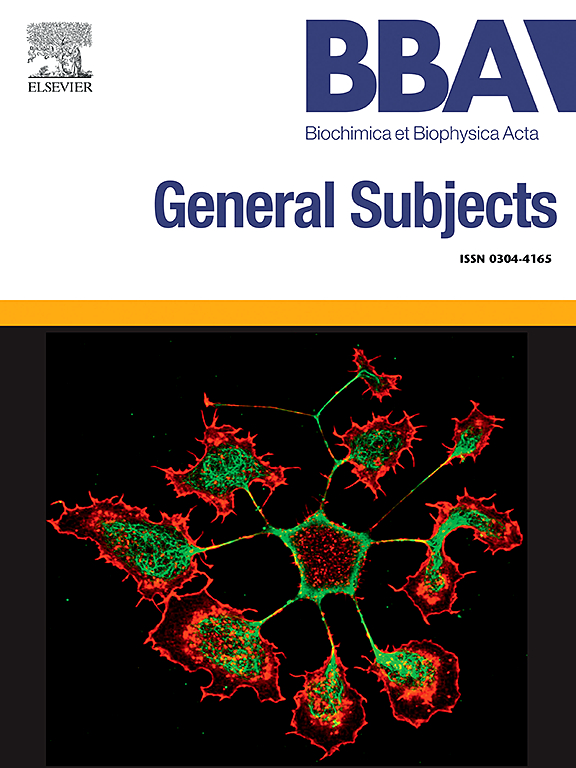血浆活化培养基通过网格蛋白依赖内吞作用抑制claudin-1的表达,破坏HaCaT细胞间屏障功能
IF 2.2
3区 生物学
Q3 BIOCHEMISTRY & MOLECULAR BIOLOGY
Biochimica et biophysica acta. General subjects
Pub Date : 2025-05-27
DOI:10.1016/j.bbagen.2025.130826
引用次数: 0
摘要
皮肤在防止内部水分流失和外部病原体入侵方面起着关键作用。CLDN1的表达水平和定位与表皮的紧密连接屏障功能有关。近年来,非热大气压等离子体(NTAPP)作为一种新的生命科学工具受到了包括皮肤科学在内的广泛关注。NTAPP的应用显示出对皮肤的有益作用,包括抗菌活性、促进伤口愈合和黑色素瘤的抗癌活性。然而,NTAPP间接照射对皮肤细胞的影响尚不清楚。本研究以人表皮角质形成细胞HaCaT细胞为实验材料,研究了ntapp辐照介质(PAM)对表皮TJ屏障功能的影响。与NTAPP (PAM0)无距离辐照的30%培养基显著降低了CLDN1蛋白的表达水平。PAM0显著降低了CLDN1在细胞-细胞接触区域的定位。经PAM0处理后,不加PAM0的进一步培养,CLDN1的表达和定位明显恢复到与对照细胞相同的水平。pam0诱导的CLDN1蛋白表达和定位的变化涉及溶酶体通过网格蛋白依赖的内吞作用降解。PAM0降低了经上皮电阻,增加了低分子量化合物的细胞间渗透性,但对高分子量化合物没有作用。本研究表明,PAM0通过降低人表皮角质形成细胞中CLDN1蛋白的TJ定位而减弱细胞间渗透性。使用NTAPP的技术可能有助于促进难以渗透到体内的药物的透皮吸收。本文章由计算机程序翻译,如有差异,请以英文原文为准。

Plasma-activated medium disrupts intercellular barrier function in HaCaT cells by suppressing claudin-1 expression via clathrin-dependent endocytosis
The skin plays a critical role in protecting against water loss from the inside and pathogen invasion from the outside. The expression levels and localization of claudin-1 (CLDN1) are responsible for the tight junction (TJ) barrier function in the epidermis. Nonthermal atmospheric pressure plasma (NTAPP) has recently received attention as a novel tool in life sciences, including dermatology. NTAPP application showed useful effects on the skin, including antimicrobial activity, wound healing promotion, and anticancer activity for melanoma. However, it remains unknown how NTAPP indirect irradiation affects skin cells. In this study, we used the human epidermal keratinocyte HaCaT cells to clarify the effect of NTAPP-irradiated medium (PAM) on the epidermal TJ barrier function. Treatment with 30 % of the medium irradiated no distance from NTAPP (PAM0) significantly decreased the expression levels of CLDN1 protein. PAM0 significantly decreased the localization of CLDN1 in the cell-cell contact area. After PAM0 treatment, further culture without PAM0 significantly restored the expression and localization of CLDN1 to the same level as in the control cells. The PAM0-induced changes in protein expression and localization of CLDN1 involve lysosome degradation via a clathrin-dependent endocytosis. Treatment with PAM0 decreases transepithelial electrical resistance and increases the intercellular permeability of low-molecular-weight compounds but not high-molecular-weight compounds. The present study shows that treatment with PAM0 weakens intercellular permeability by decreasing the TJ localization of CLDN1 protein in human epidermal keratinocytes. The technology using NTAPP may be useful to promote transdermal absorption of drugs that are difficult to permeate into the body.
求助全文
通过发布文献求助,成功后即可免费获取论文全文。
去求助
来源期刊

Biochimica et biophysica acta. General subjects
生物-生化与分子生物学
CiteScore
6.40
自引率
0.00%
发文量
139
审稿时长
30 days
期刊介绍:
BBA General Subjects accepts for submission either original, hypothesis-driven studies or reviews covering subjects in biochemistry and biophysics that are considered to have general interest for a wide audience. Manuscripts with interdisciplinary approaches are especially encouraged.
 求助内容:
求助内容: 应助结果提醒方式:
应助结果提醒方式:


